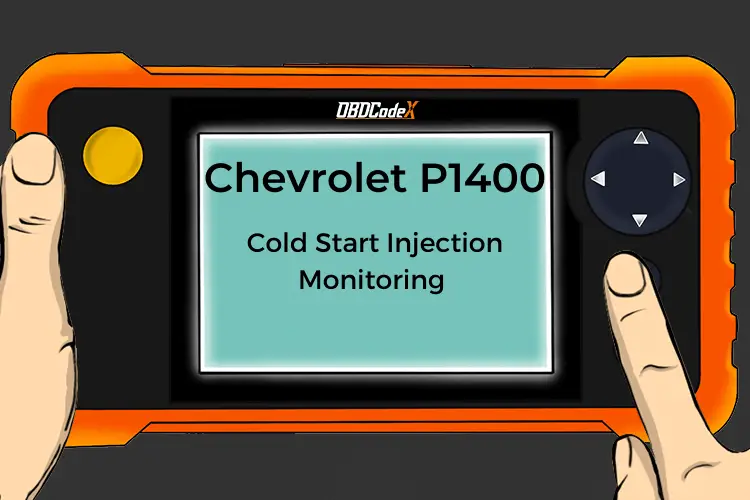P050E: Cold Start Engine Exhaust Temperature Too Low
Is your scanner showing P050E?
No worries. We'll show you what it means and how to deal with it.
P050E: Cold Start Engine Exhaust Temperature Too Low
OVERVIEWWhat Does The P050E Code Mean?
When a code P050E is stored, it means that the powertrain control module (PCM) has detected an exhaust temperature that is below the minimum threshold, at cold start. Cold start is a term used to describe a drivability strategy used only when the engine is at (or below) ambient temperature.
In my professional experience, exhaust temperature is monitored only in vehicles equipped with clean burning diesel propulsion systems.
This code is more common in geographic locations with extremely cold climates.
Changes in exhaust temperature are critical to emission reduction in today’s clean burning diesel engines. The PCM must monitor exhaust temperature in order to ensure that the desired action is being taken to accomplish these drastic changes in temperature.
Diesel exhaust fluid (DEF) injection systems are responsible for the introduction of DEF into the catalytic converter and other areas of the exhaust system.
These DEF mixtures initiate the increased exhaust temperatures required to burn harmful hydrocarbons and nitrogen dioxide particles trapped within the exhaust system. The DEF injection system is controlled by the PCM.
During engine cold start, exhaust temperature should be at or near ambient temperature. IF the PCM detects that exhaust temperature is lower than ambient temperature, a code P050E will be stored and a malfunction indicator lamp (MIL) may be illuminated. In most cases, multiple failures will be required for MIL illumination.
What Are The Symptoms Of The P050E Code?
Symptoms of a P050E engine code may include:
- Diminished engine performance
- Decreased fuel efficiency
- Excessive black smoke from the exhaust
- Accompanying DEF codes
What Are The Potential Causes Of The P050E Code?
Causes for this code may include:
- Defective exhaust temperature sensor
- Burnt or damaged exhaust temperature sensor wiring
- Moisture trapped inside the exhaust has frozen
- PCM or PCM programming error
How Serious Is This P050E Code?
When a code P050E is stored, DEF injection is likely to be disabled. This code should be categorized as severe and rectified with urgency.
How Can You Fix The P050E Code?
I would likely begin my diagnosis with a search for applicable technical service bulletins (TSB). If I can find one that matches the vehicle I am working with, the symptoms exhibited, and the codes that are stored, chances are that it will help me to diagnose the P055E accurately and quickly.
I will need a diagnostic scanner, an infrared thermometer with a laser pointer, a digital volt/ohmmeter (DVOM), and a reliable source of vehicle information to diagnose this code.
The vehicle information source will provide me with diagnostic flow charts for the P055E, wiring diagrams, connector face views, connector pin-out charts, and component testing procedures/specifications. This information will be instrumental in arriving at an accurate diagnosis.
After a visual inspection of exhaust temperature sensor wiring and connectors (with a focus on wiring that is routed near high-temperature areas), I would connect the scanner to the vehicle diagnostic port and retrieve all stored codes and pertinent data.
Code data from the scanner may be helpful later in my diagnosis. I would write it down and keep in a safe place. Now, I would clear the codes and test-drive the vehicle (at cold start) to see if the code is reset.
The test-drive should also displace any moisture that may have been previously trapped in the exhaust system.
Use the DVOM to test the exhaust temperature sensor:
- Set the DVOM to the ohms setting
- Disconnect the sensor from the wiring harness
- Use manufacturer’s specifications and testing procedures to test the sensor
- Discard the sensor if it does not comply with manufacturer’s specs
If the exhaust temperature sensor is good, test reference voltage and ground at the exhaust temperature sensor:
- With the key on and the engine off (KOEO), gain access to the exhaust temperature sensor connector
- Place the DVOM on the appropriate voltage setting (reference voltage is typically 5-volts)
- Probe the reference pin of the exhaust temperature connector with the positive test lead of the DVOM
- Probe the ground pin of the same connector with the negative test lead of the DVOM
- The DVOM should indicate a 5-volt reference (+/- 10-percent)
If reference voltage is discovered:
- Use the scanner data stream display to observe exhaust temperature
- Compare the exhaust temperature displayed on the scanner to the actual temperature that you detected using the IR thermometer
- If the two differ by more than the maximum allowable threshold, suspect exhaust temperature sensor failure
- If the two are within specifications, suspect a PCM malfunction or a programming error
If reference voltage is not discovered:
- With the KOEO, connect the negative test lead of the DVOM to a battery ground (with the positive test lead still probing the reference voltage pin of the same connector) to see if you have a voltage problem or a ground problem
- A voltage problem will need to be traced back to the PCM
- A ground problem will need to be traced back to the appropriate ground junction
- The exhaust temperature sensor is frequently confused with an oxygen sensor
- Use caution when working around hot exhaust
Recommended Parts
Below are some recommended auto parts to help you address the trouble code affecting your vehicle and get it running smoothly again:
Note: During the purchasing process, please check carefully whether the part you want to buy fits your car!
Reference Sources
ENGINE CONTROL SYSTEM [GASOLINE ENGINE (V-6)] SERVICE MANUAL for P050E – Pages 598-600.








